
How To Write Google-Topping Blog Posts For Your Law Blog
Dan Garner – Achieving top SEO rankings for your law firm can be tough – but there are key steps you can take to ensure your law firm SEO success and achieve top rankings.
Writing the most esoteric, authoritative blog post in the world will help but it may not reach the top of Google when you’re wanting to do so unless you take the necessary step to reach the top of the search engines.
You need to write quality content, most certainly. But you also need to write it in a way that makes it SEO-friendly, so that you rank high on Google and the other search engines (and never forget BING and Yahoo! and the other search engines, which is the topic for another day).
There are some really key elements to writing a top blog post, quality content being perhaps the most important, particularly for lawyers whose every word can be weighed and assessed by discriminating, potential clients.

You will have heard the oft-heard term that ‘content is king’. It’s true and more true than ever when it comes to something like legal writing.
But although you may be writing on a legal topic, you are really writing with a strong emphasis upon the SEO factors that will help propel your content to the top of the search engines.
There are some especially important factors like formatting with proper headings, paragraphs, images, and plenty of white space. User experience, relevancy, and search intent are becoming increasingly more important for Google.
By creating top quality and relevant content you are also providing Google with a top ranking signal.
It’s worth watching the video below from Google’s Matt Cutts to learn the basics of how search works –
Follow these 10 steps and you will get a blog post that achieves top ranking and – hopefully – will serve you well in terms of building on that success to develop more quality, high-ranking content also.
Let’s get started on the 10 steps towards your law firm SEO success.
1. Do Your Keyword Research

Before you start writing, you first need to do some keyword research to help focus the search engines’ attention.
Consider some key questions:
- What keywords are people currently typing into Google?
- What questions are people asking?
- What problems or legal issues are they trying to solve?
Find out what your potential clients are ALREADY searching for.
There is no point in writing plenty of content without doing the research first.
There are plenty of legal blogs around and you can see what they are doing, but some pre-planning is key to getting great online traction and securing the top positions.
There are free tools you can use to get that top position and undertake keyword research. You can use free tools like the Google Keyword Planner, SEMRush, and KeywordFinder.io to find out how many times per month people are searching for specific keywords and phrases.

A favorite and excellent free keyword tool is Ubersuggest, developed by online marketing guru Neil Patel. This tool allows you to uncover a bunch of potential long tail keywords. Identify your competitors top pages and the exact keywords they rank for. Find the approximate keyword difficulty of any keyword based on the domain authority and backlinks held
by the top 10 results.
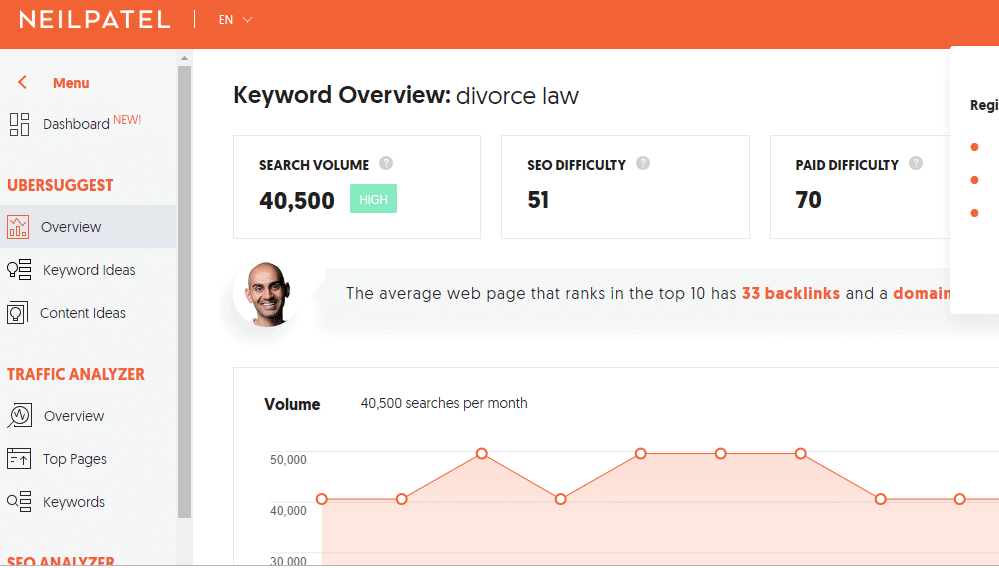
Ubersuggest is being constantly improved by Neil and is a great way to get some powerful help in finding those keywords you need as well as playing about to uncover some areas you may not have thought about.
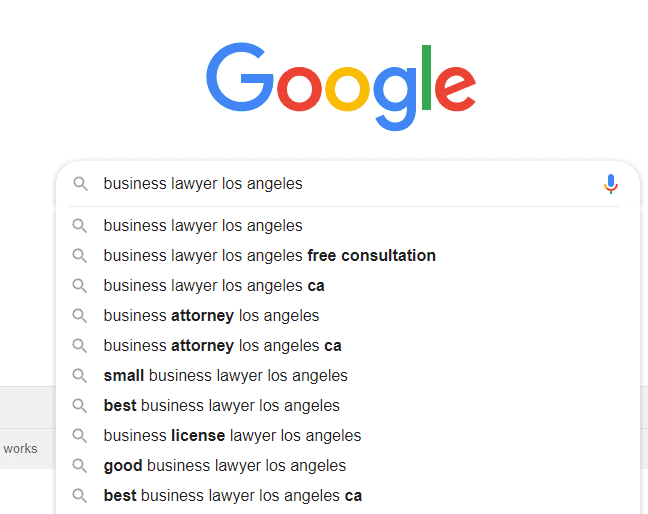
In fact, even Google themselves will tell you what people are searching for using the autosuggest tool. Simply enter a topic into the Google search bar and see what else comes up in the search bar that can prompt some keyword gold.
Carefully consider what people might be searching for –
- What types of family law service are people searching for?
- Who is searching?
- When are people searching for this? Any seasonality?
- What words are they using? What questions are they asking? Are they searching on mobile devices?
- Why are people looking for family law services? Divorce? Adoption? Estate planning?
- Where are potential clients located?
Using the tools available and doing some brain-storming will soon unearth a wealth of those invaluable keywords that are the first step towards a top ranking for your post.
2. Chase The ‘Long-Tail’ Keywords
‘Long tail’ keywords are the keywords that are easier to rank for rather than pushing and shoving with the highly competitive, shorter phrases of one or two words.
When you’re just getting started, it’s much easier to rank for low-competition, long-tail keywords that are also often more focused on your specific practice area – eg ‘crypto currency law expert’ or ‘Manchester divorce lawyer’. As your website gains more domain authority, you can start going after more competitive terms, but begin by going for those longer tail words.
In fact, half of all searches are for terms and phrases with 4+ words. And 70 per cent of all search traffic is made up of long-tail keywords.
So while everyone else is fighting over the most competitive keywords, you can focus on those more specific, targeted and ‘buyer’ keywords that represent what our potential client is actually seeking.
We have previously written about the need to identify ‘user intent’ when selecting your keywords.

Source: Moz.com
These less competitive terms are much easier to rank for but you still need to provide some high value content to achieve the sought-after top ranking.
The other benefit of long-tail keywords is that they often have a much clearer search intent (as explained above) that help you meet the needs of the ‘searcher’.
For example, if someone types into Google: ‘bankruptcy lawyer’ you know you’re gong to be up against every bankruptcy law firm everywhere.
It’s a very competitive terms, as are any other terms relating to broad areas of law. It will bring plenty of untargeted traffic to your blog when you want potential clients, rather than just traffic numbers.
(The same keyword ‘niching down’ applies to optimizing for local business search too, as we have written about before).
You need to ‘niche down’ into key areas with long-tail phrases like (for a US term):
How to find a good bankruptcy lawyer, or –
- bankruptcy lawyers near me
- cheap bankruptcy lawyers
- chapter 7 bankruptcy attorney
- garnishment lawyer
- affordable bankruptcy attorney
- chapter 13 bankruptcy attorney
Notice how as we start going more long-tail, the search intent becomes much clearer.
When you know the searchers intent, you can create much more relevant (and therefore more valuable) content for your reader that will also garner more online traction and rankings.
Google rewards those who provide relevant, valuable content that fully answers the readers question, which is easier to do when you have a longer-tail keyword to target.
3. Put Your Main Keyword in the Title
Placing your main keyword in the title is one of the most important factors to ranking well with Google. This tells your readers and the search engines what you are writing about.
It’s also one of the first things people see in the search results page. So you want to create an enticing title that also encourages people to click through on your result, moreso because you have done the ‘niche down’ effort of targeting a good, long-tail phrase.
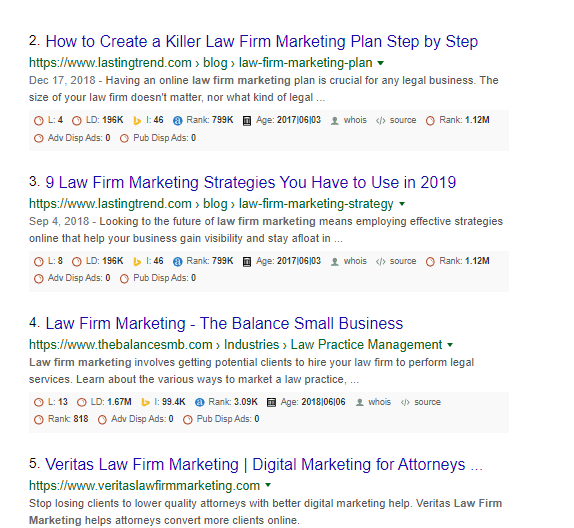
The key to a great title is a combination of both relevancy and good copywriting, together with a good headline using your keywords.
Remember that your title is, hands down, the most important element on your page. It’s the first thing people read and the deciding factor in whether or not they keep reading, so it needs to be killer. But how, exactly, do you write a killer heading?
Starting with a number and using power words in the title are two go-to’s for amping up your title copy and developing high engagement.
Your potential readers want to know what they’re getting into when they click on your link. By including the who, what, why, and how in your post title, you’re putting that information out from the get-go, which will drive more qualified clicks.
If you can, add your primary keyword to the title. The closer to the beginning of the title, the better. Including your keyword in your title will make sure your readers know exactly what the main topic of your post is – and it’ll help you rank better in the process.
You can use numbers and benefit-driven headlines to catch people’s attention and increase your click-through rates. Just be sure to include your main keyword phrase at the beginning of the title.
Google is looking at the click-through rate (“CTR”) of your search result, as a higher CTR sends them a strong signal that your content is relevant to the people clicing on it – all of which results in a higher ranking.
4. Include your keyword in the url
Inside WordPress, if you are using WordPress for your site, you can customize the url for each blog post. Also called the permalink.

This helps your readers and the search engines to immediately see what your content is all about. Always customize your url before publishing or have your webmaster do so for you.
However, ensure you do not have dates in the url, which can reduce the effectiveness and the CTR for your article, given that most people are looking for the most up-to-date content.
I find short permalinks do best. For example, if the title of your article is “5 Things To Know About Your Personal Injury Claim in Florida.”
The url slug would be:
yourwebsite.com/florida-personal-injury-claim
5. Optimize Your Headings & Images

There are three main headline tags. H1, H2, and H3 used with websites, which help the search engines know what your post is about.
Your blog post should contain just one H1 tag, which will mostly be the ame as the blog post heading.
The h2 tags are used for all of the individual sub-topics that you have while h3 tags are often used for sub-items beneath the h2 tag.
You don’t always have to use h3 tags on every page. Sometimes all you need is just H1 for the title at the top and h2 for your sub-topics underneath but using the tags is a simple but important step towards achieving your objectivbe of a top ranking blog post.
Many people overlook the ability to – let alone the importance of – optimizing images to rank in Googles’s image search.
Google has a variety of content categories that you can search for apart from content results – including images, videos, and news.
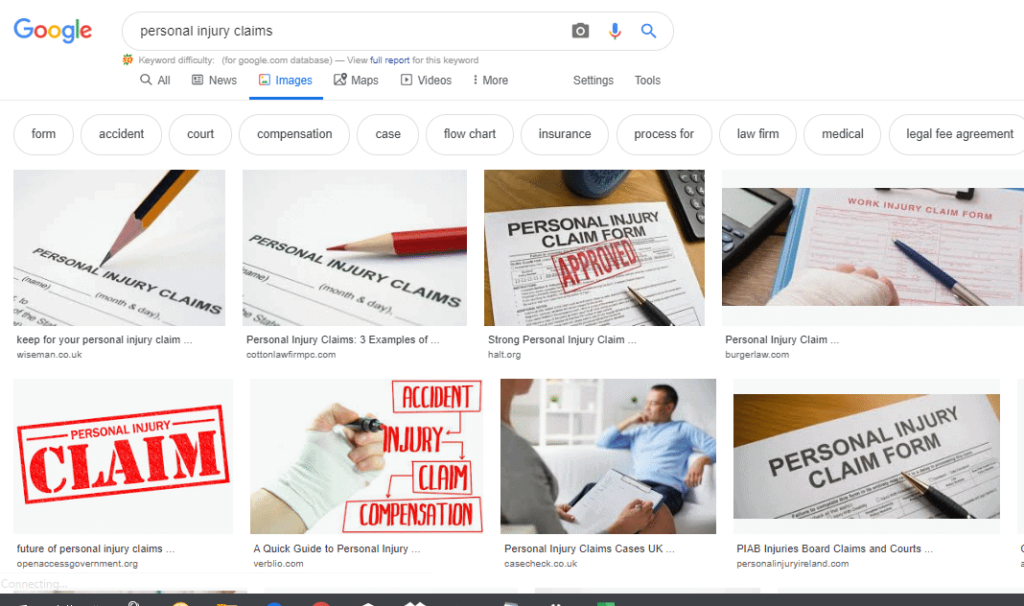
Their image search in particular gets a tremendous amount of search traffic all by itself. You can benefit from that by optimizing your images and increasing the relevance and readability of your blog post.
There are several things you can do to optimize your images.
- Name your images with relevant keywords.
- Add an alt attribute.
- Decrease the size of your images. This will help your pages load faster, which is another important Google ranking factor. Google wants to create the best possible experience for it’s users. Fast-loading is iportantl
For image optimization you can use a free tool like Kraken.io or a WordPress plugin like Shortpixel can dramatically speed up your website.
You should also look at using Schema markup to optimize your site.
Schema is computer code that enhances the rich snippets displayed under a page title in search engine results. Adding Schema markup to your site’s HTML improves how search engines read and show your page online and greatly helps achieve the law firm SEO success you want.
7. Link to Your Previous Posts
Links are still one of the most important ranking factors that Google uses in their algorithm. But it’s not just external links. Internal links also help pass “link juice” from one page to another within your website.

Source: Reliablesoft.net
Wikipedia is an great example of a website that uses a strong internal link structure to help them win thousands of top page rankings in Google and dominating the search engines across multiple topics.
It’s also important that you link to related blog posts that will help your readers explore the subject-matter further, which is especially important for lawyers seeking to build authority and relevance. By doing the cross-linking you are also passing that link juice and boosting the overall site relevance and rankings.
When possible, use relevant anchor text to link to these older posts. But it’s important to vary your anchor text, using a variety of different long-tail and related search phrases.
8. Increase Click Through Rate with Meta Descriptions
Meta descriptions do not have a rankings impact but they are important because they provide a potted description of what you have written.
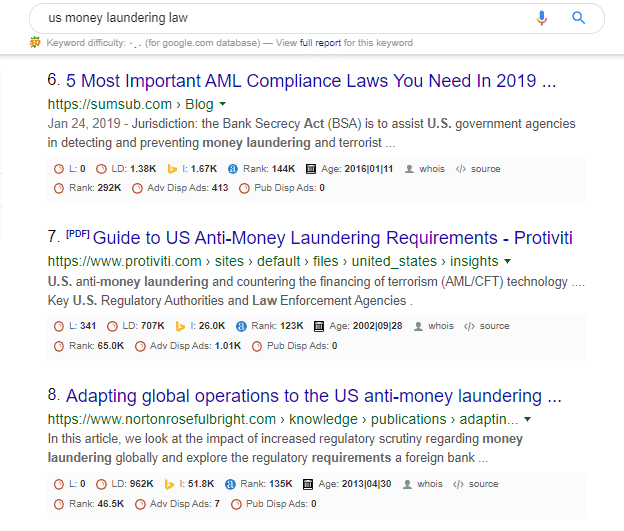
In that sense they are akin to the all-important headline in that they help attract the reader and a well written meta description is therefore extremely important to achieve that readership.
The more relevant and engaging your description, the more likely someone is to click on your result over someone else’s.
For this reason, it’s important to include your main keyword (and possibly some long tail variations) in the meta description. This let’s readers know your blog post is relevant to their search query and they’re more likely to click it.
A higher click-through rate often equates to higher rankings because it’s a signal to Google that your website is more relevant for that specific keyword phrase. But of course, there are many different ranking signals. Over 200 in fact.
Another benefit of including your main keyword phrase in the meta description is that it’s often bolded in the search engine results which obviously creates a stronger impact online.
Google may also take relevant content from your post, rather than the meta description, but you want to put yourself in the box seat for high engagement by ensuring you have a well written meta description, which will serve to optimize your post.
9. Go For Longer Posts
Studies show that blog posts with 2,000 words or more are much more likely to rank on the front page of Google.

This alone is reason enough to start creating longer blog posts.
But there are other benefits as well.
Longer posts generally provide more value to the reader. It’s hard to cover a topic in just 500 words, particularly when dealing with often arcane legal topics. But by writing a guide of 2,000 words or more, you’re able to create a comprehensive resource that answers all their questions.
In addition, research has shown that long-form content is more likely to generate quality backlinks, which we know is a top ranking factor. People are much more likely to link to long, comprehensive posts than a thin, 500-word blog post.
This is one of the main reasons that long-form content performs better on Google. In fact, Hubspot did a study on how content length affects backlinks, showing a strong correlation between the word count and the average number of linking domains.

Long-form content also gets more social media shares. As long as it’s insightful, well-written, easy-to-read, and contains plenty of visual images to help illustrate the content.
No one likes to read long “walls” of text without white space or images. So make sure your content is not just easy to read, but also easy on the eyes.
If you want to ensure that you’re able to beat your competitors in the search engines, make your content more valuable, more engaging, and more comprehensive than every other website in the top 10 results.
Remember, more often than not – the best content wins. So your goal is to make your blog post the BEST resource on your particular topic / keyword phrase.
So now let’s answer the more important question – “How long should your blog post be in order to rank on the front page of Google?“
While there’s no perfect answer, the best thing to do is study your competitors. This will give you a good idea of how much content you need to bring to the table in order to compete.
Open up Google and type in your keyword phrase. Then, find the word count for each blog post that ranks in the top 10.
Once you find the grand total of ALL 10 blog posts, divide it by 10 to find the average length. Your blog post needs to be at least this long in order to compete on the front-page.
Remember – you can always go back and improve your posts later. But the first thing you want to do is simply publish as much content as you can. Preferably at least 1,500 – 2,000 words to start with.
This can vary from market to market, but most markets these days are going to see the best results from 2,000+ word blog posts.
Remember, it often takes many months to get a new page ranking on the first page of Google. So the sooner you can get it published, the sooner you’ll start seeing rankings.
9. Link to Authority Websites
External links provide search engines with important clues on the topic relevance of a specific page. By linking to helpful websites with high authority, you’re creating a better experience for the user. It shows that you’ve done thorough research and can boost the reputation of your own content as well.
Many SEO’s believe that linking out to authority sites creates additional trust signals for Google, which various studies and reports now show strong evidence that this could well be the case.
At LawFuel we have daily requests for linking, via articles and elsewhere, because as one of the Internet’s first law firm news sites we have almost 20 years’ of ‘authority’ in the eyes of Google. All of which is one reason we have set up our LawFuelList Directory to permit firms and experts to obtain a link via that source.
Also, by linking to other sites you will attract their attention to and assist the move towards obtaining futher links back to your law firm site, thus improving your law firm SEO ranking.

Read our earlier article from law firm marketing and SEO expert Chris Dreyer who provided some top advice as to how law firms can get great backlinks using these key tools.
Good backlinks are one of the very best things a law firm can do to achieve SEO success.
10. Keep Your Posts ‘Freshly Squeezed’ – Update Old Blog Posts

Gone are the days when you could publish a new blog post, rank in the search engines, and just expect that the post will remain ‘evergreen’, driving ongoing traffic to your firm.
The need for fresh content continues and you will know that you will prefer to read the latest information on a topic rather than something older, which means it is important to update your old posts and ensure that they remain relevant and ‘fresh’.
In fact, it’s often much more advantageous to update old content rather than create a brand new blog post. By updating old content, you can often see a boost in your ranking much faster than you would with new content. Because new pages often require many months to get to the front page of Google.
Here are just a few ways you can update and improve your old content:
- Update / Add new information
- Update / Add new images
- Reshare on social media
- Fix any broken links
- Add an infographic
- Add tweetable links
- Create a new Pinterest Pin
- Add relevant internal / external links
- Add a video to your post that goes into more detail.
- Weave in new long-tail phrases that are showing up in the Google Search Console.
Find additional long-tail keywords where your page is showing up in the Google search console, but not yet ranked on page one. Go back and update your old content for these additional long-tail phrases. This adds value to your posts and brings in additional traffic.
If you’re wondering which pieces of content you should update, log into Google Analytics and look for old posts that have started to fall in the rankings over the past few months (or years).
You can also update your old blog posts simply by updating them with new information. As legal issues and cases arise, you can readily update law content that will attract a strong, targeted audience and get your ‘old’ post updated and achieving great SEO results for your law firm.
Check on which posts and articles are ranking in the top 10. Make sure that you’re covering all of the most important topics that are being covered by your competitors.
That may mean adding additional images, infographics, statistics, graphs, tables, or just updated content on the latest legal development.
Check also whether your links in the article are still the best. Are they outdated, or broken?
You can use a WordPress plugin called WP Last Modified Info to show when your posts were most recently updated.

This plugin will show the date when your post has most recently been updated. It also adds the proper schema markup that notifies Google as to when your content was most recently updated.
Updating older content is one of the easiest ways (low-hanging fruit) to increase your search engine traffic.
Final Word on Law Firm SEO Success
Having top content and writing well optimized posts targeted to your keywords is fundamental to your success with SEO.
As law marketer form the Rainmaker Institute, Stephen Fairley wrote recently:
” Every post you create adds one more indexed page to your website, which improves your chances of discovery by prospects. It also tells Google that your site is active and growing, helping to elevate it in search rankings. The fresh content drives more traffic to your site and your social media pages, also increasing your rank. Everything about blogging is good for SEO provided you are adding content your users find relevant and valuable. “
You obviously want your audience to be engaged and to receive quality, relevant, accurate information (particularly as a law firm), but you also need the roadmap we’ve outlined above to ensure that you also achieve the SEO results your’s seeking
So armed with those points you need to produce the quality content and work towards the top SEO rankings you need.
Let us know if you have questions or issues and one of the LawFuel content writers can help.
We also want to know how you’re going with your online efforts to achieve to SEO results for your law firm.
